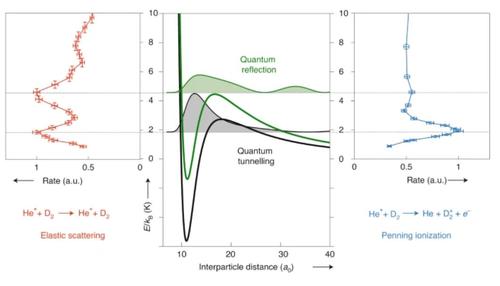Determining the nature of quantum resonances by probing elastic and reactive scattering in cold collisions
Scientists from Freie Universität Berlin, Israel's Weizmann Institute of Science, and the Netherlands' Radboud University have demonstrated two types of quantum resonances: tunneling resonances and above-barrier resonances. The team of physicists and chemists combined the merged-beam technique with VMI detection assisted by near-threshold photoionization to resolve the resonances and corroborated their findings by calculating the corresponding scattering wavefunctions.
News from Dec 05, 2020
Scattering resonances play a central role in collision processes in physics and chemistry. They help build an intuitive understanding of the collision dynamics due to the spatial localization of the scattering wavefunctions. For resonances that are localized in the reaction region, located at short separation behind the centrifugal barrier, sharp peaks in the reaction rates are the characteristic signature. If, however, the localization occurs outside of the reaction region, mostly the elastic scattering is modified. This may occur due to above-barrier resonances, the quantum analogue of classical orbiting.
By probing both elastic and inelastic scattering of metastable helium with deuterium molecules in merged-beam experiments, the scientists differentiated between the nature of quantum resonances - tunnelling resonances versus above-barrier resonances - and corroborate their findings by calculating the corresponding scattering wavefunctions.
The research findings were recently published in the renowned journal „Nature Chemistry“.
Keywords
- Christiane Koch
- cold collisions
- Daniel Reich
- elastic scattering
- Kollisionsdynamik
- merged beams
- merged-beam experiments
- metastable helium
- Nature Chemistry
- physics research
- quantum physics
- quantum resonances
- reactive scattering
- scattering wavefunctions
- unnelling resonances
- velocity map imaging
- VMI
